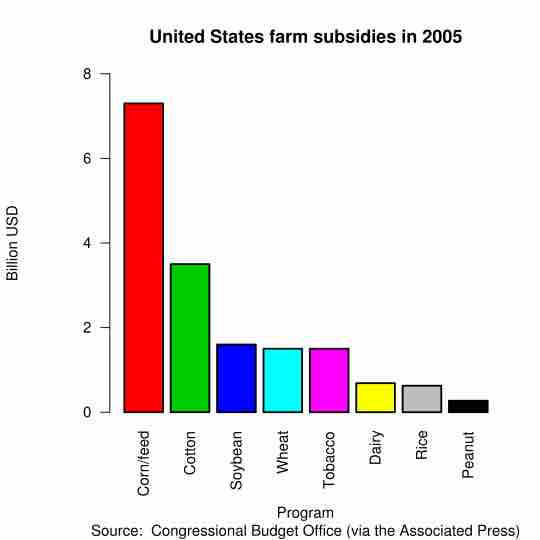Subsidy
A subsidy is assistance paid to a business, economic sector or producers. Most subsidies are paid by the government to producers or distributed as subventions in an industry to prevent the decline of that industry, to increase the prices of its products, or simply to encourage the hiring of more labor. Some subsidies are to encourage the sale of exports; some are for food to keep down the cost of living; and other subsidies encourage the expansion of farm production.

Subsidies
This graph depicts U.S. farm subsidies in 2005.
Subsidies are often regarded as a form of protectionism or trade barrier by making domestic goods and services artificially competitive against imports. Subsidies may distort markets and can impose large economic costs. Financial assistance in the form of subsidies may come from a government, but the term subsidy may also refer to assistance granted by others, such as individuals or non-governmental institutions.
Examples of industries or sectors where subsidies are often found include utilities, gasoline in the United States, welfare, farm subsidies, and (in some countries) certain aspects of student loans.
Types of Subsidies
Ways to classify subsidies include the reason behind them, the recipients of the subsidy, and the source of the funds. One of the primary ways to classify subsidies is the means of distributing the subsidy. The term subsidy may or may not have a negative connotation. A subsidy may be characterized as inefficient relative to no subsidies; inefficient relative to other means of producing the same results; or "second-best;" implying an inefficient but feasible solution.
In other cases, a subsidy may be an efficient means of correcting a market failure. For example, economic analysis may suggest that direct subsidies (cash benefits) would be more efficient than indirect subsidies (such as trade barriers); this does not necessarily imply that direct subsidies are bad, but they may be more efficient or effective than other mechanisms to achieve the same (or better) results. Insofar as they are inefficient, subsidies would generally be considered bad, as economics is the study of efficient use of limited resources.
Effects
In standard supply and demand curve diagrams, a subsidy shifts either the demand curve up or the supply curve down. Subsidies that increase the production will tend to result in lower prices, while subsidies that increase demand will tend to result in an increase in price. Both cases result in a new economic equilibrium. The recipient of the subsidy may need to be distinguished from the beneficiary of the subsidy, and this analysis will depend on elasticity of supply and demand as well as other factors. The net effect and identification of winners and losers is rarely straightforward, but subsidies generally result in a transfer of wealth from one group to another (or transfer between sub-groups).
Government Procurement
Government procurement in the United States addresses the federal government's need to acquire goods, services (including construction), and interests in real property. It involves the acquiring by contract, usually with appropriated funds, of supplies, services, and interests in real property by and for the use of the Federal Government. This is done through purchase or lease, whether the supplies, services, or interests are already in existence or must be created, developed, demonstrated, and evaluated.
The authority of a contracting officer (the Government's agent) to contract on behalf of the Government is set forth in public documents (a warrant) that a person dealing with the contracting officer can review. The contracting officer has no authority to act outside of his or her warrant or to deviate from the laws and regulations controlling Federal Government contracts. The private contracting party is held to know the limitations of the contracting officer's authority, even if the contracting officer does not. This makes contracting with the United States a very structured and restricted process. As a result, unlike in the commercial arena, where the parties have great freedom, a contract with the U.S. Government must comply with the laws and regulations that permit it, and must be made by a contracting officer with actual authority to execute the contract.